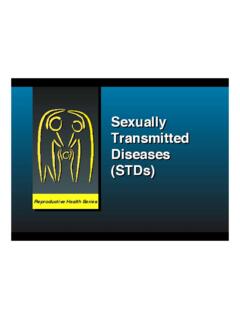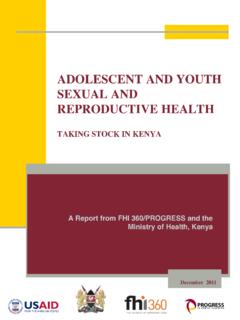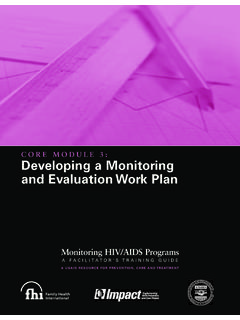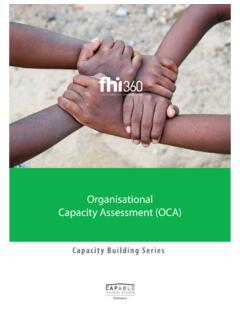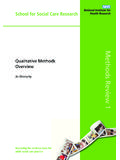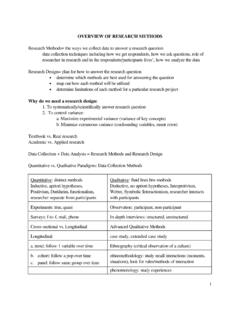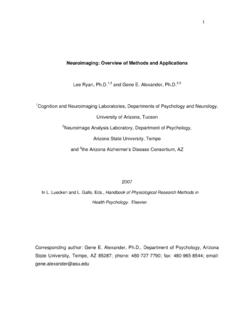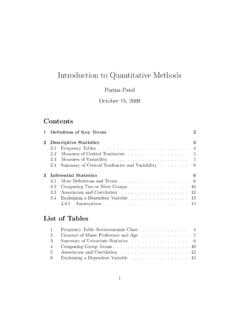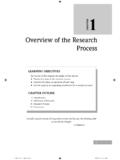Transcription of Qualitative Research Methods - FHI 360
1 QualitativeResearchMethods:A DATACOLLECTOR SFIELDGUIDENATASHAMACK CYNTHIAWOODSONGKATHLEENM. MACQUEEN GREGGUEST EMILYNAMEYIn July 2011, FHI became FHI 360 is a nonprofit human development organization dedicated to improving lives in lasting ways by advancing integrated, locally driven solutions. Our staff includes experts in health, education, nutrition, environment, economic development, civil society, gender, youth, Research and technology creating a unique mix of capabilities to address today s interrelated development challenges. FHI 360 serves more than 60 countries, all 50 states and all territories. Visit us at HEALTH INTERNATIONALQ ualitative ResearchMethods:A DATACOLLECTOR SFIELDGUIDENATASHAMACK CYNTHIAWOODSONGKATHLEENM. MACQUEEN GREGGUEST EMILYNAMEYF amily Health International (FHI) is a nonprofit organization working to improve livesworldwide through Research , education, and services in family publication was made possible through support provided by the Agency forInternational Development (USAID), under the terms of Cooperative Agreement The opinions expressed herein are those of the authors and donot necessarily reflect the views of : 0-939704-98-6 Qualitative Research Methods : A Data Collector s Field Guide 2005 by Family Health InternationalFamily Health Box 13950 Research Triangle Park, North Carolina 27709.
2 StudyviiiModule 1 Qualitative Research Methods Overview1 Introduction to Qualitative Research1 Comparing Quantitative and Qualitative Research2 Sampling in Qualitative Research5 Recruitment in Qualitative Research6 Ethical Guidelines in Qualitative Research8 Suggested Readings12 Module 2 Participant Observation13 overview of Participant Observation13 Ethical Guidelines16 Logistics of Participant Observation18 How to Be an Effective Participant Observer22 Tips for Taking Field Notes24 Suggested Readings25 Case Study Samples26 Participant Observation Steps27 Module 3 In-Depth Interviews29 overview of In-Depth Interviewing29 Ethical Guidelines31 Logistics of Interviewing32 How to Be an Effective Interviewer37 Tips for Taking Interview Notes44 Suggested Readings45 Case Study Samples46 Interview Steps48 Interview Checklist49 Module 4 Focus Groups51 overview of Focus Groups51 Ethical Guidelines53 Logistics of Focus Groups54 How to Be an Effective Moderator59 How to Be an Effective Note-taker69 Tips for Taking Focus Group Notes73 Suggested Readings77 Case Study Samples68, 70, 74, 78ivSteps in Moderating a Focus Group80 Steps in Note-taking for a Focus Group81 Focus Group Checklist82 Module 5 Data Documentation and Management: Organizing and Storing Your Data83 Converting Raw Data to Computer Files83 Organizing Data Storage85 Suggested Readings87 Case Study Samples86, 88 Data Archiving Steps90 Data Management Checklist91 Appendix A: Exercises for Training Data Collectors93 Appendix B: Tools for Data Managers105 Glossary115 List of TablesTable 1.
3 Comparison of quantitative and Qualitative Research approaches3 Table 2. Strengths and weaknesses of participant observation15 Table 3. What to observe during participant observation20 Table 4. Strengths of in-depth interviews versus focus groups30 Table 5. Key skills for in-depth interviewing38 Table 6. Unbiased versus leading questions42 Table 7. Strengths of focus groups versus in-depth interviews52 Table 8. Behavioral techniques for building rapport in focus groups60 Table 9. Suggested ground rules for building rapport in focus groups61 Table 10. Unbiased versus leading questions64 Qualitative Research Methods : A Data Collector s Field GuidevAcknowledgmentsThis field guide is the creation of all the authors. However, we especially recognize CynthiaWoodsong as its originator and inspiration. It is she who began crafting training materials duringthe course of her many public health projects in field sites far and wide, as she sought to prepareteams for the immediate while equipping them with skills to collect data for other Research proj-ects in the future.
4 During these training experiences, she perceived a recurring need to providefield teams with foundational, practical information on Qualitative Methods , presented in a formthat was self-contained, tangible, and easy to consult during the action moments of data collec-tion. Dr. Woodsong built upon her repertoire of need-to-know training materials with each suc-ceeding project. In turn, these materials, many of which she developed with funding from National Institutes of Health, have provided the bulk of the substance for the present fieldguide. Too, Dr. Woodsong s vision for capacity building in developing country settings remainsour collective vision for this field would also like to recognize the conceptual contributions of Betsy Tolley and Lorie emphasis on the importance of allowing for individual approaches to preparing researchteams for data collection served as a reminder that a practical field guide should not portend to be atraining curriculum in and of itself.
5 Rather than a replacement for hands-on interaction betweentrainers and data collection teams, we intend our guide to be a useful supplement for each teammember as they learn and use Qualitative Methods in the Betty Akumatey of the University of Ghana, Legon, and Joy Noel Baumgartner ofFHI merit our sincere thanks as well. Their candid evaluations helped us measure our goal ofdeveloping a functional tool against the reality of whether it worked in the field. We thank alsoBeth Robinson for her encouragement, enthusiasm, and technical and personal support from thestart of this project to its finish. Thank you to Larry Severy for his all-round backing of the proj-ect. Merrill Wolf, editor, is due thanks for the manuscript s organization and flow, as is KarenDickerson, copyeditor and designer, for her great attention to detail and consistency. Illustrationsare credited to Denise Todloski. Kerry McLoughlin graciously stepped in at a moment s notice toprovide assistance with the case study examples.
6 And Lucy Harber, our gentle, smiling produc-tion manager, was indispensable in ways immeasurable for bringing the project to guide was made possible by funding from the Agency for International Development(USAID). We extend our gratitude for their unwavering Research Methods are gaining in popularity outside the traditional academic socialsciences, particularly in public health and international development Research . Whereas quantitativeresearch Methods once dominated these fields, researchers have now begun drawing from a morediverse repertoire of methodologies as they tackle international public health problems. Qualitativemethods have become important tools within this broader approach to applied Research , in largepart because they provide valuable insights into the local perspectives of study great contribution of Qualitative Research is the culturally specific and contextually rich data itproduces. Such data are proving critical in the design of comprehensive solutions to public healthproblems in developing countries, as scientists, medical doctors, pharmaceutical companies, andhumanitarian organizations have come to recognize that biomedical solutions are only partialremedies.
7 Rather, the success of a health intervention that is, whether it actually reaches the peo-ple it is intended to help rests also on how well it addresses sociobehavioral factors such as cul-tural norms, ethnic identities, gender norms, stigma, and socioeconomic status. Success measuredon this basis has a bearing, in turn, on the cost-effectiveness, efficiency, and efficacy of interven-tions, concerns not insignificant in the eyes of project managers and funding this field guideThis field guide is based on an approach to doing team-based, collaborative Qualitative Research thathas repeatedly proven successful in Research projects sponsored by Family Health International(FHI) throughout the developing world. With its straightforward delivery of information on the mainqualitative Methods being used in public health Research today, the guide speaks to the need for sim-ple yet effective instruction on how to do systematic and ethically sound Qualitative Research .
8 Theaim of the guide is thus practical. In bypassing extensive discussion on the theoretical underpinningsof Qualitative Research , it distinguishes itself as a how-to guide to be used in the have designed the guide as a tool for training the data collection staff members of multisite andteam-based public health projects, but it easily has application for smaller-scale or multidisciplinaryprojects as well. It is also applicable to researchers spanning a wide range of expertise, from begin-ners to the more practiced , anyone wishing to learn or review the basics of Qualitative data col-lection and management. We should point out, also, that even as our style of presenting the methodsmakes them accessible to people without an extensive background in Qualitative Research , we do notneglect important methodological nuances and details that can affect the quality of a motivation for this guide is our belief that focusing on the mechanics of systematic data col-lection and management will help to prepare data collectors well for the rigors and inevitablechallenges of applied Research in developing countries.
9 In turn, well-trained data collectors willbe better equipped to execute Research protocols smoothly to the extent that real-life circum-stances allow and ultimately produce a data set of superior guide is divided into five modules covering the following topics:Module 1 Qualitative Research Methods OverviewModule 2 Participant ObservationModule 3 In-Depth InterviewsModule 4 Focus GroupsModule 5 Data Documentation and ManagementQualitative Research Methods : A Data Collector s Field GuideviiThis modular design is meant to make it easy for readers to find information about a particulartopic quickly. Each of the three modules on specific Qualitative Research Methods contains anoverview of the method being discussed, relevant ethical guidelines, step-by-step instructions,examples from a fictitious case study, checklists, and suggestions for further reading. In the inter-est of keeping each module self-contained, information applicable to more than one method isrepeated in each relevant module.
10 Much of the information is presented in a question-and-answerformat, which is intended to anticipate questions that people new to Qualitative Research mighthave. In addition, throughout the guide, we provide examples from real or hypothetical researchstudies to illustrate concepts, Methods , and other issues guide s appendices contain materials of interest to trainers and team leaders, including train-ing exercises. An appendix focusing on data management, which is often an overwhelming task inmultisite and team-based projects, represents an effort to make this task less for data managers, it includes tools and suggestions for data management , a glossary of terms frequently used in Qualitative Research appears at the end of the to use this field guideAs noted, the primary audience for this guide is field staff. We want field staff, whether experi-enced or novice, to have at their fingertips all the information they need to be able to go out andcollect data.


